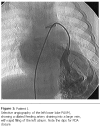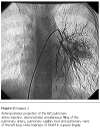Congenital pulmonary arteriovenous malformation: a rare cause of cyanosis in childhood
- PMID: 21532721
- PMCID: PMC2984296
Congenital pulmonary arteriovenous malformation: a rare cause of cyanosis in childhood
Abstract
Pulmonary arteriovenous malformation (PAVM) is a rare condition in which there is abnormal connection between pulmonary arteries and veins. The disorder usually appears in late childhood or early adult life, with dyspnea on exertion, clubbing or cyanosis. We present two patients with severe cyanosis and their work-up to diagnosis of PAVM, as a rare cause of cyanosis in childhood.
Keywords: Cyanosis; Pulmonary arteriovenous malformation; Right to left shunting.
Figures


Similar articles
-
Pulmonary arteriovenous malformation: a rare cause of cyanosis in a child.Singapore Med J. 2009 Apr;50(4):e127-9. Singapore Med J. 2009. PMID: 19421665
-
[A rare cause of cyanosis in childhood: Pulmonary arteriovenous malformation].Turk Kardiyol Dern Ars. 2017 Sep;45(6):538-540. doi: 10.5543/tkda.2016.57262. Turk Kardiyol Dern Ars. 2017. PMID: 28902645 Turkish.
-
Pulmonary arteriovenous malformation managed by VATS lobectomy.Rozhl Chir. 2020 Fall;99(10):467-471. Rozhl Chir. 2020. PMID: 33242965 English.
-
Cyanosis due to pulmonary arteriovenous malformation.Am Fam Physician. 1988 Oct;38(4):187-91. Am Fam Physician. 1988. PMID: 3051975 Review.
-
Pulmonary arteriovenous malformation in the newborn: a familial case.Pediatr Cardiol. 1993 Jan;14(1):58-61. doi: 10.1007/BF00794850. Pediatr Cardiol. 1993. PMID: 8456028 Review.
Cited by
-
Pulmonary Arteriovenous Malformation: Not all Hypoxemia During Covid-19 is the Same.Eur J Case Rep Intern Med. 2024 Nov 25;11(12):005027. doi: 10.12890/2024_005027. eCollection 2024. Eur J Case Rep Intern Med. 2024. PMID: 39651385 Free PMC article.
References
-
- Gossage James R, Kanj Ghassan. Pulmonary arteriovenous malformation, A state of art review. Am J Respir Crit Care Med. 1998;158:643–661. - PubMed
-
- Allen SW, Whitfield JM, Clarke DR. et al. Pulmonary arteriovenous malformation in the newborn: a familial case. Pediatr Cardiol. 1993 Jan;14(1):58–61. - PubMed
-
- McAllister KA, Grogg KM, Johnson DW. et al. Endoglin, a TGF-beta binding protein of endothelial cells, is the gene for hereditary haemorrhagic telangiectasia type 1. Nat Genet. 1994 Dec;8(4):345–51. - PubMed
-
- Lange PA, Stoller JK. The hepatopulmonary syndrome. Ann. Intern. Med. 1995;122:521–529. - PubMed
-
- Prager RL, Laws KH, Bender HW. Arteriovenous fistula of the lung. Ann Thoracic Surgery. 1983;36:231–239. - PubMed
LinkOut - more resources
Full Text Sources
